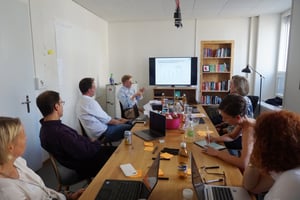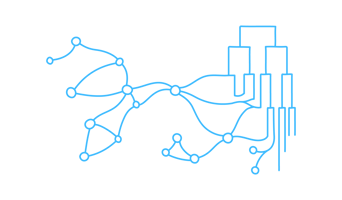Organizational agility is a top priority for senior leaders to enable continuous adaptation to a changing environment. Human resources has a key role to play in building the agile organization. We identify five levers at HR’s disposal to promote organizational agility.
Many organizations want to become more agile to support continuous change, dynamic adaptations to new market conditions, and an entrepreneurial empowerment of their workforce. HR obviously must play a crucial role in this transformation.
But what key levers must the HR function pull in order to have an impact and promote agile human resource management? And what is the right approach for HR to be seen as a valuable service provider and thought leader? We discuss five key angles where HR is best positioned to take the lead.
1. Practice what you preach: HR as a pioneer in new organizational designs and agile HR practices
I had the privilege of working with two HR teams from large Swiss corporations as they implemented new organizational systems relying, in large part, on self-managed teams and decentralized authority.
Both cases had their unique features and particularities. But they had one key aspect in common: motivation from the leaders triggered the experiment. In both cases, HR leaders sought to experiment with new, agile methods internally, within the HR function, in order to learn and to build firsthand experiences and legitimacy.
This meant that when the business divisions approached their HR partners to inquire about innovative approaches to organizing, HR not only knew what they were talking about, but also had concrete experience to share.
The HR managers had become experts in a particular form of organizing.
They also had had the opportunity to identify and consider the key questions that come with such an effort:
-
Should you define your own agile set-up or should you go with an off-the-shelf framework
-
How do you define an experimental space where it’s okay not to have all the answers but to learn and (re-)design the agile model as you go along?
-
How do you plan for the effort and costs?
-
How much (and which kind of) support do you have to put in place?
2. Rethinking what leaders are and what leaders should be: Developing “agile” leadership capabilities
HR is typically the owner of learning and leadership development in many organizations. Those functions are also among the key levers when it comes to building agile organizations.
In this context, however, it is important to understand that not all forms of leadership are the same.
The understanding of leadership based on a classic hierarchical model that consists of the three most basic elements – “boss”, his or her “direct reports”, and the according “reporting relationship” – implies different developmental priorities than new forms of organizing or agile set-ups.
The classic understanding of leaders and leadership focuses on the boss, as well as that person’s roles and behaviors as they deal with their underlings.
Fostering agile leadership capabilities on the other hand focuses more on cooperation, shared leadership between team members, and lateral leadership between equals. This is because one shared feature of new forms of organizing and agile setups is a different configuration of hierarchy within an organization. This leads to shifting roles between leaders and followers depending on the context and the situation. And finally, the focus of a leadership development initiative is much more than, for example, just formal leadership roles, and the population addressed is broader than just young leaders.
The priorities for HR are therefore developing a shared understanding of what agile leadership means, defining the implications for any existing leadership development program that may be in place, and adapting its initiatives accordingly.
Boost organizational effectiveness
with Management Kits
3. Contributing to an agile culture: Support the behaviors that foster agile practices
“Organizational culture” comprises the everyday rules and routines that shape how people communicate, collaborate, behave, or, in short, how they go about their work.
An agile culture would be one that supports agile practices. For example, it would support behaviors that create the optimal level of transparency for people to promote the organization’s purpose. It would support behaviors that allow for a change in direction as circumstances change. It would support behaviors that allow people to confidently and safely fulfill their roles and communicate with others. To name just a few …
In a classic organization, “tone from the top” is important. A key HR lever in this respect is recruiting, selection, and promotion.
One simple question in this regard is: what kind of experiences should future managers have throughout their working lives?
For example,
-
have they successfully contributed to an agile project?
-
Have they had first-hand experience driving digital innovation?
-
Have they shown leadership without having the authority to direct the people working with and around them?
4. Career paths and talent management: Focus on employee value beyond the pyramid career ladder
Speaking of the experiences of future managers, career planning and managing talent is a fourth key function under the control of HR that can be brought into the service of the agile transition.
Many career path models are aligned with a “path-up-the-pyramid” logic of progress, expert tracks notwithstanding. Once the organization (and the pyramid) is much flatter, and the roles that each individual holds change more frequently (and laterally) by design, those pyramid models will have to be re-designed as well. Stepping stones toward an alternative model would be, for example:
-
How are changing/multiple roles accounted for?
-
What experiences (projects, achievements, failures) is a leader at the senior level expected to have mastered?
-
How much weight is given to entrepreneurial and intrapreneurial episodes and achievements (and, for that matter, to failures)?
Talent management in the narrow sense should start with an empathic understanding of how your people are doing while working with your organization, plain and simple.
5. Accompanying change: HR as strategic partner for an agile transformation
Depending on an organization’s priorities and its target model for an agile transformation, the change can be profound for its people.
HR must expand its change-management toolbox in order to address the unique challenges that result from new ways of working, especially if the transformation involves a whole new approach to formal authority and hierarchy within an organization.
One pertinent example is the change experienced by middle managers who are asked to move into shared leadership roles as a result of new organizational models.
Think of the distribution of authority and roles in Holacracy, with its lead links, rep links, secretary, and facilitator, or the “tribes and squads” model with its differentiation of product owner, chapter lead, tribe lead, and agile coach. This is a long way from the classic boss role. The corner office and the executive chair are (generally) already things of the past – and now the role itself is being challenged!
The implications of this go beyond the step-change initiatives within the confines of classic forms of organizing that are almost business-as-usual in many corporate setups.
On the contrary, an agile target state has different qualities, and the implications for change planning are immense. They affect the very role HR needs to play, and the capabilities HR needs to build (see point 1 above).
The Agile Organizing Kit provides research-based practical guidance to boost organizational agility
Note: This blog post and another one on organizational agility and intrapreneurship are based on a presentation given to an HR manager workshop organized by the BlueLion Incubator Zurich in August 2019. I am grateful to the BlueLion Foundation and Caroline Wiedemer in particular for the kind invitation and the opportunity for a very energetic and insightful discussion.



